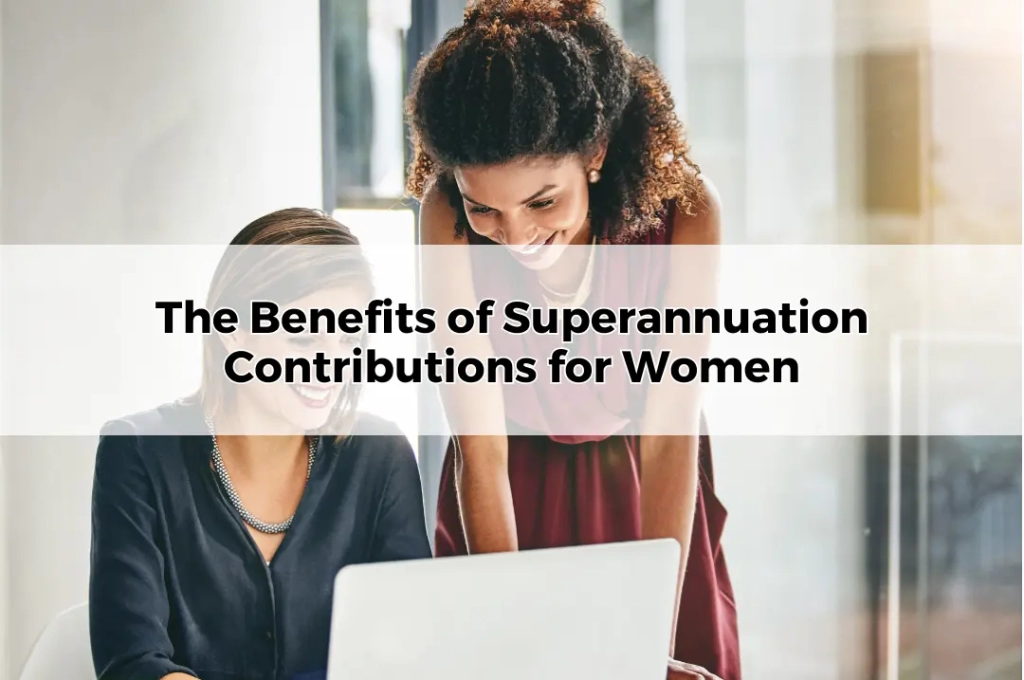The Benefits of Superannuation Contributions for Women
Table of Contents
ToggleSuperannuation plays a pivotal role in ensuring financial security during retirement. For women, contributing to superannuation is even more critical due to the specific challenges they often face in building wealth for later life. The superannuation system is designed to help Australians accumulate savings throughout their working lives, providing an essential income stream in retirement.
However, women generally experience lower superannuation balances than men at retirement, making it essential to understand how to maximise contributions. By focusing on the unique financial realities women encounter, strategic superannuation contributions can ensure a comfortable and independent retirement. Understanding the benefits and opportunities superannuation provides is the first step towards achieving long-term financial well-being.
The Gender Superannuation Gap
The gender superannuation gap refers to the significant disparity in retirement savings between men and women. On average, women retire with much less super than their male counterparts. Several factors contribute to this imbalance, including the gender pay gap, career breaks to raise children, and part-time employment, which many women engage in during their careers.
This gap can have profound consequences for women’s financial security in retirement. Without adequate superannuation, women are more likely to face financial difficulties in later life. Therefore, addressing the superannuation gap is essential, and women must take proactive steps to maximise their contributions and safeguard their financial futures.
Why Women Need to Focus on Superannuation Contributions
Career breaks, part-time work, and caring responsibilities often impact women’s ability to contribute consistently to their superannuation. As women are more likely to step away from full-time employment to care for children or ageing relatives, these breaks can significantly reduce their overall super balance.
Focusing on regular super contributions, even during part-time work or career breaks, can have a long-term positive impact. By contributing consistently and making use of various superannuation incentives, women can reduce the gap created by their working patterns. Taking charge of super contributions is an essential strategy for ensuring a stable and independent retirement.
Maximising Concessional Contributions
Concessional contributions refer to pre-tax super contributions, including employer contributions and salary sacrifice. These contributions are taxed at a concessional rate of 15%, often lower than an individual’s marginal tax rate, making it a tax-efficient way to boost superannuation.
Women can benefit from salary sacrificing, where a portion of their pre-tax income is directed into their superannuation fund. This not only increases their super balance but also reduces their taxable income, providing immediate tax savings. By consistently maximising concessional contributions, women can significantly enhance their superannuation savings and minimise the effects of career breaks.
The Power of Non-Concessional Contributions
Non-concessional contributions are made from after-tax income and are not taxed when they enter the super fund. While they do not offer immediate tax benefits, they can play a powerful role in increasing super balances. Non-concessional contributions are especially useful for women who may have received a windfall, such as an inheritance or a large bonus, and wish to boost their retirement savings.
By making non-concessional contributions, women can take advantage of the superannuation system’s tax benefits in the long term. These contributions can grow tax-free within the super fund, providing a significant boost to retirement savings over time.
Government Co-Contribution Scheme
The government co-contribution scheme is designed to help low and middle-income earners increase their super balances. If a woman’s total income is below a certain threshold and she makes a personal after-tax contribution to her super fund, the government will contribute up to $500 to her superannuation account.
This scheme provides an excellent opportunity for women with lower incomes, especially those working part-time or earning below the threshold, to accelerate their super savings. By making modest contributions, eligible women can benefit from additional funds to help close the superannuation gap.
The Importance of Catch-Up Contributions
The catch-up contributions rule allows individuals to make extra super contributions if they have not used their concessional contribution cap in previous years. Women with interrupted career paths or periods of reduced income can carry forward unused portions of their concessional contributions for up to five years.
This rule is particularly beneficial for women who have taken time off work for parental leave or other caregiving responsibilities. By making larger contributions during more financially stable periods, women can compensate for lower contributions during career breaks, ensuring their super balance remains on track.
Spousal Contributions and Super Splitting
Spousal contributions and superannuation splitting offer ways for couples to balance their superannuation savings. If a woman’s spouse makes contributions to her super fund, he may be eligible for a tax offset, providing a win-win situation for both parties. Additionally, super splitting allows one partner to transfer part of their super contributions to their spouse’s account, helping to equalise superannuation balances.
This strategy is particularly useful in scenarios where one partner, often the woman, has a lower super balance due to career breaks. By working together, couples can ensure both parties are financially secure in retirement.
Superannuation and Parental Leave
Parental leave, while a vital part of family life, can significantly affect a woman’s superannuation balance. Without employer super contributions during maternity leave, women often experience a gap in their super savings. This break can compound over time, particularly for those who take extended periods out of the workforce.
To address this shortfall, women can consider making voluntary super contributions during parental leave. Additionally, employers and policymakers are increasingly recognising the importance of continuing superannuation payments during parental leave, which could help reduce the gender super gap in the long term.
The Role of Compound Interest in Superannuation Growth
One of the most powerful forces in building wealth through superannuation is compound interest. The earlier women start contributing to their super, the more time their contributions have to grow. Even small, regular contributions made early in a career can accumulate significantly over time due to compounding.
Women who take proactive steps to contribute consistently, even during periods of part-time work, can leverage compound interest to their advantage. This long-term growth ensures that superannuation savings increase exponentially, helping to secure a comfortable retirement.
Superannuation and Retirement Planning for Women
Women typically live longer than men, which means they need a larger superannuation balance to fund a longer retirement. Given this reality, retirement planning must account for both longevity and potential gaps in super contributions. By making superannuation a priority and taking advantage of all available incentives, women can plan for a secure and independent retirement.
Superannuation strategies that include regular contributions, spousal contributions, and government incentives can help women accumulate sufficient savings. Early planning is essential to ensure that women are well-prepared for retirement, with a super balance that can support a comfortable lifestyle.
Conclusion
Navigating the complexities of superannuation can be challenging, especially when aiming to optimise contributions and maximise benefits. Working with a Toowoomba Financial Adviser can provide invaluable guidance tailored to women’s unique financial needs. A professional adviser can help women develop personalised strategies that take full advantage of concessional and non-concessional contributions, government incentives, and superannuation splitting.
At Wealth Factory, we specialise in helping women build strong financial foundations for retirement. By working with a financial adviser, women can confidently navigate the superannuation system, ensuring their savings grow steadily and their financial future is secure.









